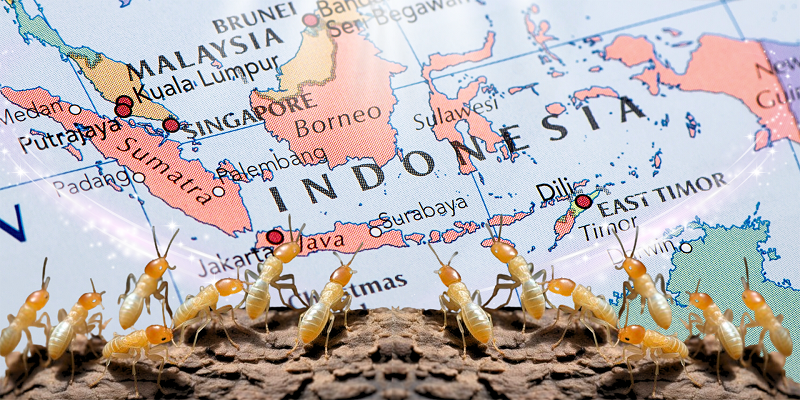- Head Office : Ruko Apartemen Serpong Green View RK3, RT01/03, Jl. Lengkong Gudang Timur Raya, Serpong, Tangerang Selatan

Termite Habitat in Indonesia
Indonesia is a tropical country with the third-largest forest area in the world, approximately 96 million hectares, or half of its total land area. Many buildings in Indonesia, including some modern ones, still use wood as a primary construction material. Wood is readily available and has properties well-suited for Indonesia’s tropical climate. The presence of tropical regions, such as in Indonesia, makes it a favored habitat for various insects, including termites.
Characteristics of Termites
Termites thrive optimally in subtropical and tropical regions. While termites can be damaging, they also play a significant role in ecosystems. Termites help humans as ecosystem engineers by breaking down and decaying dying plants into food for other animals and cleaning up fallen leaves and wood, which are then converted into humus that fertilizes tropical forest soil. This contribution has a positive impact on ecosystem balance and supports environmental sustainability.
Several types of termites are common in Indonesia, including subterranean termites and wood termites. These two types differ in habitat, behavior, and the extent of damage they cause. Subterranean termites typically live in the soil and build tunnels for their nests and food sources. These termites are more likely to damage building structures and wood buried in the soil. They can infiltrate through small cracks and damage building foundations.
In contrast, wood termites usually live in wood and can be found in building wood or furniture. They do not require soil to survive and create tunnels within the wood. Wood termites focus more on damaging wood structures inside homes or wooden furniture.
Unprocessed or poorly protected wood can be particularly attractive to termites and cause damage to buildings. Therefore, protecting wood from termite attacks is a crucial aspect of building construction in areas with high termite risk. Termites are considered dangerous pests due to their "silent invader" nature. Not only wood products, but also other cellulose-containing items are vulnerable to termite attacks. Examples include cabinets, door and window frames, kitchen sets, ceilings, paper money, clothing, wallpaper, books, gypsum, cardboard, and various other items.
Similar to ants, termites live in colonies consisting of three castes: the queen, soldiers, and workers. The queen is responsible for laying and hatching eggs, soldiers guard the nest, and workers forage for food for the colony members. Before becoming a queen, the reproductive caste starts as winged termites, commonly known as alates. At night, alates emerge to find mates. Only about 1 percent of pairs succeed in mating to form a new colony. However, a queen can produce up to 50,000 eggs daily, allowing termite colonies to grow rapidly.
With the rapid reproduction of termites and the extensive forested areas, along with favorable climatic conditions supporting termite population growth, Indonesia is indeed a "paradise for termites." Although termites play an important ecological role in ecosystems, their high presence in Indonesia also presents challenges, particularly in protecting buildings and wooden items.
Prevention Methods
Pest prevention is crucial to avoid problems caused by pests, including termites. This involves ensuring that homes and surrounding areas are kept clean and free of food debris or trash that can attract pests. Immediately repair any water leaks or drainage issues, as high moisture can attract pests like termites. Check and repair any gaps or damage in building structures, including roofs, windows, and doors, to prevent pests from entering the home. Store unused wood away from the house and ensure that wood used for construction or furniture is protected from soil moisture. Regularly inspect your home, especially wooden parts, to detect signs of pest infestation as early as possible. If you suspect or see signs of pests, consult a professional pest control service for inspection and follow-up actions regarding your pest problem. The cost of termite control can vary depending on several factors, including the level of infestation, property type and size, and the treatment method used.
In this context, collaboration between the government, community, and pest experts is necessary to develop effective strategies for managing termite populations. Preventive measures, the use of protective technology, and public education about prevention actions can be part of a holistic solution. This way, Indonesia can remain a natural "paradise" for termites without compromising the protection of property and the environment from potential damage caused by abundant termite populations.